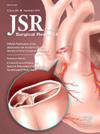Fatal Pediatric Firearm Injuries: When and Where are Children at Risk?
IF 1.8
3区 医学
Q2 SURGERY
引用次数: 0
Abstract
Objective
In 2022, firearms injured or killed more than 6000 American children. Significant disparities exist in injury risk. We hypothesized that analyzing an injury's time, date, and location could help identify additional risk and protective factors in the pediatric population.
Methods
We performed a retrospective analysis of the 2003-2020 National Violent Death Reporting System. The National Violent Death Reporting System currently collects data from all 50 states, the District of Columbia, and Puerto Rico. Demographic (age, sex, race/ethnicity) and incident (date, time, location) data were abstracted. Inclusion criteria were pediatric victims (age≤18) of fatal firearm injuries. Records with missing values were excluded. Chi-squared tests were used to test the association between victim demographics and time, date, or location. Significance was P < 0.05.
Results
Nine thousand fifty-eight children (male: 83.5% [n = 7559]), age: 17 yrs old (interquartile range: 15-18 years old), Black: 64.1% [n = 5810]) were eligible. 6161 (68.1%) of children had not completed high school. 3308 (36.5%) fatal injuries occurred after school or at night (1601-2359 h). 3678 (40.6%) injuries occurred at home. Black children were significantly more likely to be injured during the summer months (June – August, P < 0.01), after school or at night (P < 0.001), and along a street (P < 0.001). Hispanic children were more likely to be killed after school or at night (P < 0.001) and along a street (P < 0.001). There was no seasonal variation in this demographic. Compared to other times of the day, there was a significant increase in weekend (Friday-Sunday) morning (0000- 0800) injuries. (P < 0.001).
Conclusions
Firearm violence disproportionately impacts Black children. There are significant associations with the time and season. Interventions during those times such as extended academic engagement or after school programs beyond the traditional school day and school year may afford opportunities which could mitigate exposure to firearm violence.
致命的小儿枪伤:儿童在何时何地面临风险?
目标:2022 年,枪支造成 6000 多名美国儿童受伤或死亡。受伤风险存在显著差异。我们假设,分析伤害发生的时间、日期和地点有助于确定儿科人群的其他风险和保护因素:我们对 2003-2020 年全国暴力死亡报告系统进行了回顾性分析。全国暴力死亡报告系统目前收集了来自美国 50 个州、哥伦比亚特区和波多黎各的数据。人口统计学(年龄、性别、种族/民族)和事件(日期、时间、地点)数据均已摘录。纳入标准是致命枪伤的儿科受害者(年龄小于 18 岁)。缺失值的记录将被排除。采用卡方检验法检验受害者人口统计学特征与时间、日期或地点之间的关联。结果以 P 表示显著性:958 名儿童(男性:83.5% [n = 7559])、年龄:17 岁(四分位间范围:15-18 岁)、黑人:64.1% [n = 5810])符合条件。6161(68.1%)名儿童未完成高中学业。3308人(36.5%)的致命伤发生在放学后或夜间(1601-2359 h)。3678起(40.6%)伤害发生在家中。黑人儿童在夏季(6 月至 8 月,P)受伤的几率明显更高:枪支暴力对黑人儿童的影响尤为严重。时间和季节有明显的关联。在这些时间段进行干预,如在传统的上学日和学年之外延长学习时间或课后活动,可能会提供一些机会,从而减少接触枪支暴力的机会。
本文章由计算机程序翻译,如有差异,请以英文原文为准。
求助全文
约1分钟内获得全文
求助全文
来源期刊
CiteScore
3.90
自引率
4.50%
发文量
627
审稿时长
138 days
期刊介绍:
The Journal of Surgical Research: Clinical and Laboratory Investigation publishes original articles concerned with clinical and laboratory investigations relevant to surgical practice and teaching. The journal emphasizes reports of clinical investigations or fundamental research bearing directly on surgical management that will be of general interest to a broad range of surgeons and surgical researchers. The articles presented need not have been the products of surgeons or of surgical laboratories.
The Journal of Surgical Research also features review articles and special articles relating to educational, research, or social issues of interest to the academic surgical community.

 求助内容:
求助内容: 应助结果提醒方式:
应助结果提醒方式:


